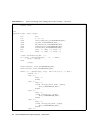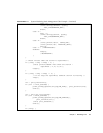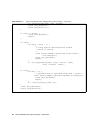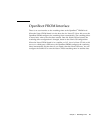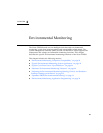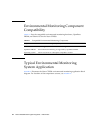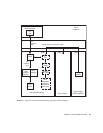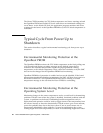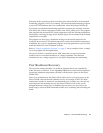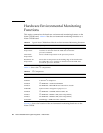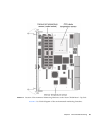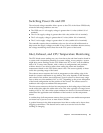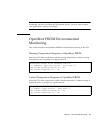
26 Netra CP2500 Board Programming Guide • March 2007
The Netra CP2500 monitors its CPU diode temperature and issues warnings at both
the OpenBoot PROM and Solaris OS levels when these environmental readings are
out of limits. At the Solaris OS level, the application program monitors and issues
warnings for the board. At the OpenBoot PROM level, the CPU diode temperature is
monitored.
Typical Cycle From Power Up to
Shutdown
This section describes a typical environmental monitoring cycle from power up to
shutdown.
Environmental Monitoring Protection at the
OpenBoot PROM
The OpenBoot PROM monitors the CPU diode temperature at the fixed polling rate
of 10 seconds and displays warning messages on the default output device
whenever the measured temperature exceeds the preprogrammed warning
temperature or the critical temperature. These values have defaults set by the SMC
and can not be changed for the OpenBoot PROM-level monitoring.
OpenBoot PROM-level protection is enabled and can not be disabled. If the board
temperature exceeds the shutdown temperature, the SMC will shut down power to
the Netra CP2500 CPU. The OpenBoot PROM will send a warning or critical
temperature message to the user that the Netra CP2500 is overheating.
Environmental Monitoring Protection at the
Operating System Level
Monitoring changes in the sensor temperatures can be a useful tool for determining
problems with the room where the system is installed, functional problems with the
system, or problems on the board. Establishing baseline temperatures early in
deployment and operation could be used to trigger alarms if the temperatures from
the sensors increase or decrease dramatically. If all the sensors go to room ambient,
power has probably been lost to the host system. If one or more sensors rise in
temperature substantially, there might be a system fan malfunction, the system
cooling might have been compromised, or room air conditioning might have failed.



